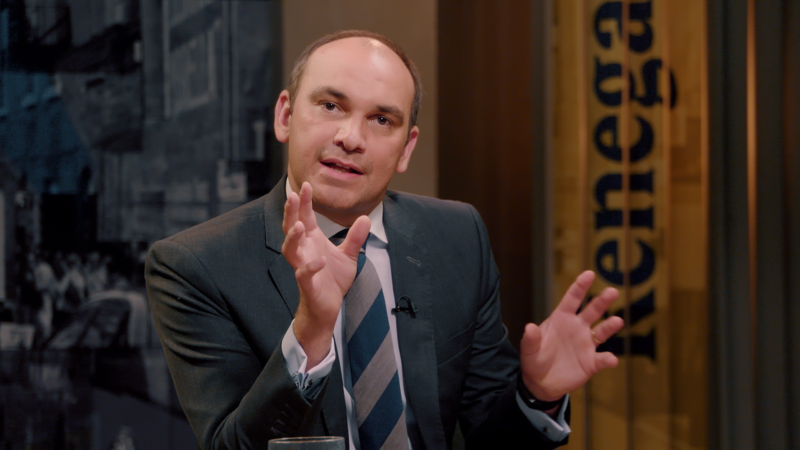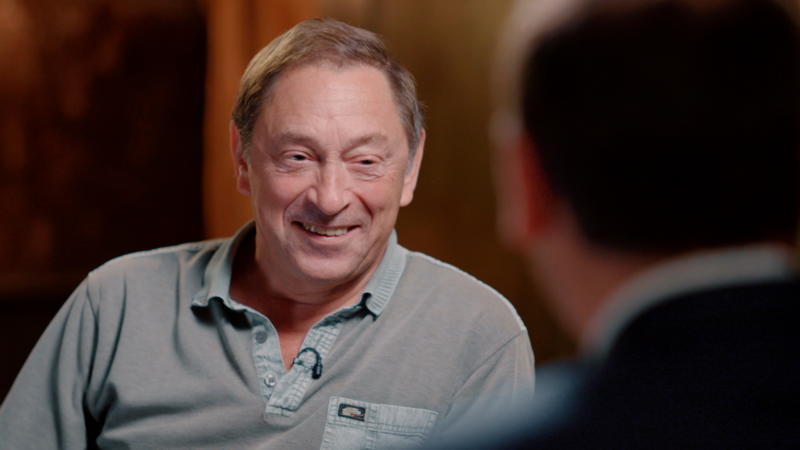Today 55 percent of the world’s population live in urban areas. But that figure is expected to increase to nearly 70 percent in just 30 years time.
Many of us make the assumption that cities are a safe haven or a controlled environment able to negate the effects of man-made climate change.
But what if this assumption is counter-intuitive and actually it’s the city dwellers who are most vulnerable to the effects of climate breakdown especially as the so-called solutions to make cities resilient, livable and sustainable are simply not radical enough
Host Ross Ashcroft is joined by the author and professor Ashley Dawson to discuss modern urban life, and why so-called solutions to make cities resilient, inhabitable and sustainable are simply not radical enough.
In his book, Extreme Cities, author Ashley Dawson talks about two huge global tides – one is urbanization and the other, he argues, is climate change. “Over the last 50 years”, says Dawson, “humanity went from a predominantly rural species to being a predominantly city-dwelling species”. China typifies this latest migratory phase where people are moving from rural areas to industrialized coastal areas looking for jobs that are invariably environmentally precarious and badly paid.

It is within this context that urbanization and climate change can be seen to overlap culminating in huge humanitarian and environmental risks indicative of climate breakdown. The dual environmental and humanitarian disaster facing Mayor Bloomberg’s planned environmentally sustainable waterfront zones in New York City is an irony not lost on Dawson:
“And so if you go to Long Island City now they’re all these, you know, huge skyscrapers right next to the East River. And it’s a flood zone. In fact, many of those areas were flooded during Hurricane Sandy. Now you know only parts of New York were flooded in Sandy and it hasn’t happened really significantly since Sandy.”
Dawson points to New Orleans as an illustration of how swamp areas south of the city, which historically have absorbed the force of storms, are currently “losing about a football fields worth of land per hour of those swampland areas” partly as a result of them being cut into by the oil and gas industry. “They cut canals and then this saltwater erodes the land”, says Dawson. Consequently, the author predicts that cities like New Orleans and Miami ( the latter built on a porous rock formation of limestone), will unlikely to be sustainable over the long term.
“As sea levels rise, the waters can get much more easily into the land. And you can’t keep them back because if you build a wall…the water will just come underneath it. So basically the bottom third of Florida is going to be flooded in the next generation or so”, says Dawson.
The infrastructural projects constructed in prime real state locations whose stated function is to protect citizens and property from the impacts of climate breakdown are, in other words, temporary measures that address the symptom but don’t actually tackle its root causes.
An entire ‘culture industry’ has been developed around the idea of tackling the environmental and human impacts of climate change by bringing together prominent design teams, engineers and architects – what Dawson refers to as ‘starchitects’. This group of people are able to garner a great deal of prestige because their (unacknowledged) ‘green-washing’ strategies are deemed by the wider public to be beneficial in terms of their perceived ability to tackle the human and environmental dangers that climate change poses.
But as Dawson says, this ‘feel good’ strategy ignores the bigger problems, namely, that “capitalism continues to drive these completely unsustainable forms of urbanization.” Consequently, in Dawson’s experience, starchitects are keen to pass the buck when challenged about what their role actually is within the existing system of financialization. It’s a system in which highly profitable infrastructural projects feed into the notion of the said feel-good factor.
But, as Dawson points out, this circular logic is negated as a result of the destructive impacts resulting from the rapacious profit motive as the catalyst for their construction:
“And so you have a small sector of elites who’ve been making money hand over fist globally. They have to do something with that money, right? There are two things that they do with it. They put it back into the stock market, so money can make more money off money. And the other thing they do is they’ve put it into real estate and fancy skyscrapers, right? So you get these crazy skyscrapers going up in places that make no sense.”
Another of capitalism’s contradictions relates to the issue of urban sprawl which becomes totally counterproductive when it comes to talking about climate breakdown. Urban sprawl happens because you need workers to not only service the debts given to them by the rich, but the rich rely on them to clean their apartments and offices and to nanny their children. These are often tax haven locations that the poor can’t afford to live in and so are forced to use high polluting transport to get to work which is a threat to the climate.
This phenomenon, in a nutshell, is the economics of apartheid. Those least responsible for climate change – the poorest – are devastated the most by its impacts mainly in cities that have a lot of concrete (the urban heat island effect). These cities get really hot in the summertime and kill thousands of mainly poor people and people of colour who don’t have dense social networks who can help them survive in these conditions. “There was a heatwave in 2003 which killed over 20000 people in Europe in the summer of 2003 and most people don’t know about that”, says Dawson.
The author, though, sees hope on the horizon:
“I think that people are quite capable of making ties with one another and fighting the kinds of slow violence that is happening. The left should be looking for ways to build that kind of person to person connection. And so some of the efforts to develop popular climate action plans in cities like New York and Barcelona and other places I think is very much about mobilizing those kinds of horizontal peer to peer connections and not sort of sitting around waiting for the state or someone else to sort it out.”
However:
“All too often the state doesn’t and instead is part of reproducing or making inequality worse. But I also think that there are important political push backs and that the left, you know, around the time of the Occupy movement and the Arab Spring was very much caught up in a kind of anarchist refusal to engage with the state. I think that’s starting to change. And particularly here in the United States, the horrendous policies of the Trump administration has given rise to a real social ferment and we’ve seen some political traction coming out of that with the election of folks like Alexandria Ocasio-Cortez.”
Dawson continues:
“All of that said, though, You know we’ve got this reactionary person in charge here. I think it’s important to understand Trump not as an anomaly, but as part of a broader problem that essentially neoliberalism has made things so bad for so many people that they’re willing to embrace very extreme ideologies…..He has a sort of drill baby drill kind of attitude about fossil fuels and it’s appealing to some working-class people. I think that that kind of attitude isn’t just about one horrendous politician like Trump, it is a reflection of the kind of contradictions of the present moment. And there have to be very strong progressive arguments against that.”
The contradictions and anomalies outlined are manifested in the inability of urban planners in a city like New York to deal with climate chaos as envisaged through the lens of free-market capitalism.
Dawson believes that a massive rethink is required around theorizing and planning predicated on thinking smarter about how we interact with urban spaces:
“I don’t want to discard the [starchitect] profession as a whole. There’s a lot of interesting thought being done about how to live in a more sustainable relationship to natural systems including, you know, flood plans and similar kinds of things. So there’s a lot of imaginative stuff being done”, says Dawson.
However, the author points to a lack of emphasis on social justice indicative of disaster capitalist nations where civil society and communities have been hollowed out of the structures of the state.
Dawson points to the example of Puerto Rico:
“You know it’s this place that’s been a colony of the United States for at least a century and of the Spanish before. The impact of Hurricane Maria meant that the whole electric grid was totally destroyed. And now they’re trying to rebuild it using natural gas and to privatize what was previously a public institution. So rather than making public and rather than switching it to solar power, there’s this completely disaster capitalist scheme unfolding that’s not going to be sustainable.
The degeneration of civil society into what the philosopher Thomas Hobbes describes as the ‘war of all against all’, is seen by neoliberal apologists as a corollary to capitalist ideology. What Dawson refers to as Disaster ‘communism’, on the other hand, is seen by the system’s critics as the antidote to the kind of Mad Max scenario envisaged by Hobbes.
“If you look at movies about future societies, that’s what is presented. It’s really brutal. And even when we’re not talking about environmental collapse, it’s still that scenario. So think about a zombie. Zombie culture is everywhere and I think it is some way of representing the kind of antagonisms that the capitalist system is creating today including environmental antagonisms”, says Dawson.
Zombie capitalist culture is what the establishment encourage but, as Dawson suggests in his book, this is not illustrative of the reality.
“When a disaster like a hurricane happens”, says Dawson, “people form organizations on the fly that can help one another. After Hurricane Sandy here in New York, I show how that really happened – how the Occupy movement turned into Occupy Sandy and was able to act much more quickly to get aid to people and teach them how to help one another, while FEMA, the Red Cross and other official agencies that were supposed to be helping people, were completely absent.”
Dawson adds:
“I think we need a leftist movement which is trying to empower the grassroots and making claims on the state. We need to be saying ‘these are our plans’, ‘this is what we want.’ ‘We want to take over the state and make it do these things’. ‘But we also want a broader social movement.’ I feel like today we are facing a choice between socialism or barbarism. The extreme form of [neoliberal] capitalism that we’ve had around the globe over the last 40 or 50 years and centrist solutions that the Barack Obama’s of the world and the Hillary Clinton’s put forward – don’t work for people anymore either economically or ideologically.”
Dawson continues:
“And so I think they’re turning to kind of neo fascist solutions like what we have with Trump or increasingly to socialist solutions. So I think we need to really put forward claims on the state and good plans around environmental issues, but then on a host of other kinds of issues. I think that’s why the Green New Deal is so exciting and positive, because it’s a plan to rebuild our infrastructure to cope with the coming climate change. But it’s also a mass employment plan for decent wages and for good jobs. And that’s the kind of connection and intersection we need.”
Dawson says that the lefts prioritization in advocating for meeting people’s essential needs, and the elites resistance to this, is tantamount to a class war – a point that the Occupy movement were effective in reminding people about.
Dawson says the left have been losing the class war and that “the elites have been smashing us through austerity for years and years” – a point that was freely admitted by Warren Buffett.
Dawson appears to suggest that the notion we are close to a tipping point at which people will take up pitchforks in order to fight back, is more than wishful thinking:
“Thomas Frank who wrote about Kansas has this wonderful line where he sort of says that in America you get the rabble turning up in front of the palaces of the elite with pitchforks and their call is cut the 1 percent taxes. That’s because that’s where we’ve got”, says Dawson. Frank helps focus the minds of those who continue to falsely believe that middle of the road ‘centrist’ solutions to climate chaos and inequality are the right solutions – an issue subsequently taken up by the gilets jaunes movement.
With gilets jaunes and the word apocalypse in mind (the latter is derived from the Greek, unveiling of new knowledge), Ashley Dawson lifts the veil by highlighting three things – from a political, individual and community perspective – that we can do to help solve the current crisis:
“I think it’s really important for people to figure out ways to overcome isolation and to cultivate forms of disaster communism – to connect with their neighbours. We can’t soft pedal the information about climate change because here in this country, particularly, we have climate change deniers in power. So we have to keep telling people what the science is saying and then also offer people things to do – whether it’s around survival or around building a mass movement that’s making demands. Those I think are really important things to do and that’s where hope comes.
Dawson concludes:
“From the political level, it’s really important to use some of the new kinds of strategies for mobilizing masses of people. I’m thinking about the kind of techniques that Bernie Sanders used in his campaign. And then we need a lot of intellectual work about making plans for what we’re going to do once we get in power. And that’s where something like the Green New Deal is very exciting and very necessary. I’m hopeful. I think globally speaking, we are kind of in a dark movement and the left in places like Latin America is not out of power. So there has to be a period of rebuilding and coming up with strategies to take power. But yeah, I think we need to think about that. And in the United States at least it does feel like a hopeful moment to me.”

In this special edition of Renegade Inc., we met up with a key adviser to PM, Boris Johnson.

We look back over the year at some of our best interviews.

A dangerous new class of socioeconomically excluded people called the precariat is on the rise.